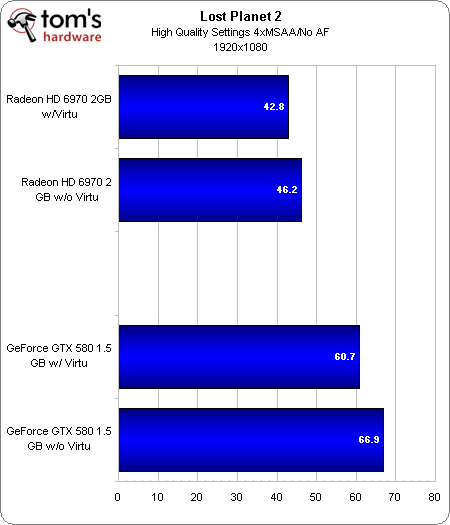Can Lucidlogix Right Sandy Bridge’s Wrongs? Virtu, Previewed
Quick Sync was Intel's secret Sandy Bridge weapon, kept quiet for five years and unveiled at the very last moment. But there's a chance that desktop enthusiasts will miss out on that functionality. That is, unless Lucidlogix has anything to do with it.
Benchmark Results: Virtu In Action
We plucked Battlefield: Bad Company 2 out of our usual benchmark suite, and were immediately impressed to see this DirectX 11-based title running through the Intel HD Graphics output at 1920x1080.
The performance drop attributable to Virtu is relatively minor in both cases. Although the GeForce GTX 580 takes a larger performance hit, I still consider >90 frames per second in Bad Company 2 well worth picking up Quick Sync support.
We see the same situation in F1 2010, as AMD’s Radeon HD 6970 loses a paltry three frames per second, while the GeForce GTX 580 takes a roughly 10% performance hit. Nevertheless, 70 frames per second are still ample to enjoy this title at 1920x1080 and 4x anti-aliasing.
Same story, different game. A relatively minor performance drop doesn’t affect playability in any meaningful way.
This time it’s the AMD card taking a larger penalty, while Nvidia’s GeForce GTX 580 comes out barely scathed at all.
In three of four cases, we were able to run a DirectX 11-based title through Intel’s integrated graphics engine. And World of Warcraft might employ DirectX 9, but there’s no way we’d see such compelling results at 1920x1080 using Ultra quality settings and Intel’s modest integrated core.
Get Tom's Hardware's best news and in-depth reviews, straight to your inbox.
Current page: Benchmark Results: Virtu In Action
Prev Page Benchmark Results: 3DMark11 Next Page Benchmark Results: The Exceptions, Explained-
mister g I'm pretty sure that Fusion only works with AMD parts, but the idea whould be the same. Anybody else remember this company's ads on the side of some of Tom's articles?Reply -
I suppose a multi-monitor setup, main screen for gaming on the discrete card (assuming game only uses that one screen), secondary on the Z68 Output of the Intel HD card, will not have any need for this, and just run perfectly.Reply
Thats how i will roll, once Z68 gets out. -
haplo602 seems like we are heading to what voodoo graphics and TV tuners were doing long long time ago. just now over the PCIe bus.Reply
I wonder why it's so difficult to map framebuffers and create virtual screens ? -
RobinPanties This sounds like software technology that should be built straight into OS's, instead of added as separate layers... maybe OS manufacturer's need to wake up (*cough* Microsoft)Reply -
truehighroller I already sent back my sandy bridge setup, that's to bad. Guess it's Intel's loss huh?Reply -
lradunovic77 This is another absolutely useless piece of crap. Why in the world would you put deal with another stupid layer and why would you use Intel integrated graphic chip (or any integrated solution) along with your dedicated video card???Reply
Conclusion of this article is...don't go with such nonsense solution.




